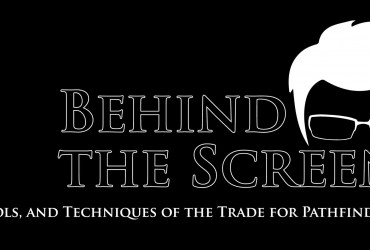Welcome to Guidance, Private Sanctuary’s source for tips and techniques for the Pathfinder Roleplaying Game, written by Everyman Gamer Alexander Augunas. Today, we’re going to be talking about which element to pick as a kineticist.
Occult October has officially begun, so that means that its FINALLY time to talk about the occult classes! By now I assume that most of my readers know about the existence of Occult Adventure’s six new classes, but if you’re like most people, then chances are you’re TOTALLY overwhelmed by how complex each of these new classes are. Its okay, you can admit it; it is a VERY common critique that I’ve heard from players.
In the long run, a complex class is better for the game than a simple class, so rather than complain about it we’re going to dissect some of these new classes. To start, we’re going to be looking at the kineticist, master of the four elements (and then some).
Elemental Royale
Whenever a new class option is available, the first thing that happens is that optimizers start trying to figure out what the “best” available option is. Sometimes this is easy, sometimes it isn’t. Whatever the outcome, some people choose to ignore it favor of focusing on character flavor, but invariably someone makes a claim, and then people start gravitating to that claim. It’s World of Warcraft all over again, folks!
So naturally, when the kineticist came out players immediately started trying to figure out which kineticist element was the “best.” But trying to figure that out is NOT easy because the kineticist has something that no other class has had before; the class gives you the option to mesh elements together without penalty. To put this in perspective, this would be like the oracle class giving you the option to start picking revelations from a second mystery for free at high levels. The elemental combinations that can come from the kineticist are, as a result, extremely varied. In an effort to try and simplify a very complicated system, at 1st level you pick your “base” element, and you get access to the wild talents for that element. At 5th level, you can choose to either expand into a second element or focus on your base element, both of which have advantages and disadvantages. For example, starting with fire and then focusing on fire gives you access to the blue flame composite blast, while going into another element can net you magma (earth), steam (water), plasma (air), or aetheric boost (aether). Furthermore, if you expand your element options, you can pick wild talents from your new element using your kineticist level –4 for meeting prerequisites (effectively 2 spell levels lower) while if you focus your element, you get a free utility wild talent or infusion.
As you can guess, it is no easy task to assess kineticist levels. I have a math-brained buddy at the Philly Lodge who spent over 12 HOURS trying to figure it out before he had an answer. His answer was earth, and here’s why:
Why Earth is the Best Element
Earth is the best element because it has a heavy focus on keeping your butt alive, as well as the butts of your party members. Talents allow you to create cover, give yourself DR, and block enemy attacks if you ready your actions well. Earth has some fantastic movement options, namely the ability to meld with stone while burrowing like an earth elemental, meaning that most of the time you can take a quick exit on stage left. Its composite blasts are all solid options, and various wild talents allow you to copy powerful spells like stone shape, move earth, and even earthquake. If all that wasn’t enough, you get tremorsense.
Now, all of this is well and good, but one of our local Venture Lieutenants disagreed. He claimed that fire was the best element. Here’s why.
Why Fire is the Best Element
Fire is the best element because it is absolutely explosive at dealing damage. It gains the ability to shape its blasts into virtually any shape, and it can even burn away spell resistance and fire resistance. What it lacks in defense, it makes up in useful abilities like firesight, which makes fire and smoke no longer impede the kineticist’s vision. It also has constant flame shield, the ability to make fires larger or smaller, the ability to ignore extreme weather, and finishes with the ability to transform yourself into a freaking phoenix. If all that wasn’t great enough, fire has awesome synergy with other elements, gaining powerful composite blasts like steam, magma, and plasma. As the most flashiest element, it also has the absolute coolist visions. Blast someone with plasma? Heck yes!
Locked in disagreement, my Venture Lieutennant and Math Guy asked one of my friends (we’ll call him Bard) to settle their disagreement. So Bard looked through the kineticist and was ready to present his decision. Here’s what he said.
Why Air is the Best Element
Air is the best element because it is so ridiculously mobile, both in terms of what I can do and in terms of what I can do to my enemies. Sure, earth and aether get a lot of the same, “I knock you all around the place” abilities, but can they fly while doing it? Like, ACTUALLY fly? I didn’t think so. Air has a great combination of blasts; one energy, one physical, and it has some of the best movement-themed abilities in the game, from making incredible leaps to spreading messages all over the place. And while we’re at it, let’s talk about creating hurricanes and tornadoes, or effortlessly pushing away ranged attacks. If I get REALLY high-level, I can even control the freaking weather whenever I want! Bow to me mortals, for I AM YOUR GOD AND I AM WRATHFUL!
So naturally, my friends couldn’t agree, so they asked me what I thought, just as many of the Know Direction Network’s readers and listeners have. And even after several months and some play experience with my own kineticist, I have the perfect answer.
Elemental Balance
All of the elements are perfectly balanced with one another for one simple reason: all of the elements excel at a different party role. Air can’t be better than earth because earth can’t do what air does. Sure, many of the elements dabble in each other’s niches in terms of their infusions, but all of the elements have vastly unique utility talents, which completely define what the kineticist can and can’t do. You’ve probably figured out some of the niches by now, so let’s highlight them quickly.
- Aether: This element is incredible at roguish skills and abilities. It can use skills from far away like an arcane trickster, turn invisible, and has basic levitation tactics. It also has access to all of the combat maneuvers through various utility talents and infusions, and its combat maneuver-focused infusions beat the pants off of the various infusions because they use the kineticist’s caster level instead of her base attack bonus, ultimately meaning they’re more likely to go off. Plus you can pick people up and slam them into each other; that’s awesome!
- Air: This element is strongest at mobility, namely moving quickly. Air gains bonuses on Acrobatics checks to move and jump around, a true fly speed, and it even gains the ability to cast HASTE on the party whenever it wants (although the duration is pretty pathetic unless you accept burn). Air’s unique infusions and utility talents also have a fair bent on defense against projectiles and combat maneuvers based around pushing enemies around. Finally, air has TWO great simple blasts and some of the most useful composite blasts, making it a solid choice at all levels.
- Earth: This element is strongest at defense. It can create cover, grant the kineticist damage reduction, and even gains tremorsense. It has a fair amount of combat maneuver bliss, mostly focused around making enemies unable to move. And yes, you heard correctly; earth has a talent that is VERY similar to black tentacles. You know you want it!
- Fire: This element is strongest at damage, especially area attacks. Fire can cause enemies to catch on fire, burning for additional damage each turn. It also gains bonuses to attack things that it set on fire as well as the ability to shape its blasts into virtually any size and shape. Fire is also surprisingly effective against opponents with spell resistance, as it has the ability to burn away spell resistance and even fire resistance at high levels. The amount of damage that you can pull off as a pyrokinetist is pretty crazy, really.
- Water: This element is strongest at versitility. Water is a weird element because like air, it has two separate types of blasts; a cold energy blast and a piercing ice blast. But unlike air, the playstyle between these two playstyles is CRAZY different; water is more like air in that it is very combat maneuver heavy while ice is like earth in that it is very defensive. Water also gets some entanglement abilities, but overall it is very “jack of all trades;” it has decent defense, decent area attacks, and decent mobility.
So looking at each of these, you might be able to pick one you like. That said, each element has its own balancing factor, which I’m going to talk about now.
Elemental Drawbacks
In addition to being good at something, each element also has its own personal “flaw” that you either have to deal with or talent out of. Let’s talk about them, shall we?
- Aether: This element’s weakness is damage. Aether doesn’t have many ways to deal damage to multiple opponents, and its composite blast is the weakest of all of them. Its focused blast deals force damage, and while that means it basically can’t have its damage reduced or negated it also deals less damage than any other composite blast. Finally, aether doesn’t have any energy blasts save for force blast, meaning its always resolving against AC rather than touch AC.
- Air: This element’s weakness is infusions. Air has fewer infusions than any other element, and it has fewer infusions that it doesn’t share with other elements. Further still, air’s infusions tend to be divided between air and electricity, meaning that you quickly start to favor one blast over the other, and when something is immune to your “specialized blast,” you’re not completely out of the game like fire is, but you’re still at a steep disadvantage.
- Earth: This element’s weakness is mobility. Earth has more movement types than any other element, but its movement types are slower than the flight from aether/air/fire or the swim speed from water. Earth’s movement speeds are limited to things made of earth or stone, meaning that you might not have them based upon the environment that the encounter takesp lace in.
- Fire: This element’s weakness is fire immunity. Fire does not have any effective methods for dealing with fire immunity, meaning that there are going to be fights where a fire kineticist is relegated to crossbow duty. Its very unfun to be put in that situation, but at least you’re likely to have Precise Shot.
- Water: This element’s weakness is its versatility. Water’s greatest strength is also something of a downside. Water’s tricks are often split between ice and water, meaning that using one blast is often at the expense of other blasts.
So yes, every element has its strengths and its weaknesses. But at the end of the day, all of the elements are awesome choices that leaves the kineticist as an amazingly fun to play character class, no matter which combination of elements you choose.
So here we are, the conclusion of the first Guidance article of Occult October. What do you think, kineticist fans? Did I miss something important when talking about the elements? Am I totally wrong about all of the elements being more or less equal? What have you seen a kineticist do in play? Leave me your answers and questions below, and come back on Friday when I show you a fun kineticist iconic design! Take care.
Alexander “Alex” Augunas has been playing roleplaying games since 2007, which isn’t nearly as long as 90% of his colleagues. Alexander is an active freelancer for the Pathfinder Roleplaying Game and is best known as the author of the Pact Magic Unbound series by Radiance House. Alex is the owner of Everyman Gaming, LLC and is often stylized as the Everyman Gamer in honor of Guidance’s original home. Alex also cohosts the Private Sanctuary Podcast, along with fellow blogger Anthony Li, and you can follow their exploits on Facebook in the 3.5 Private Sanctuary Group, or on Alex’s Twitter, @AlJAug.







You pretty much hit the nail on the head. Each of the elements are pretty evenly balanced against each other in that they each tend to play a little differently. I will say I like the hydrokineticist and aetherkineticist best, however. I really love the plethroa of utility for the telekinetic or the versatility of the hydrokinetic.
One of the really cool aspects of the elements is each one can fit into a classic archetype for characters; you could, pretty easily, make an entire story of all kineticist characters and make it pretty believable.
Aether is the rogue, she’s tricky and resourceful and can get the group out of tight jams.
Air is the scout and sniper, he attacks from extreme range and he will let you know what’s going on in rooms hundreds of feet away.
Earth is the bruiser, he’ll always be around to beat someone’s face in and he’ll stop the enemy from getting too close to his allies.
Fire is the demolisher, he’s going to utterly destroy everything in his path, while relying on his allies to back him up.
Water is the back up and support, she’s good in every single role, while not excelling in any given role; in many ways, she’s a good candidate for “the Hero” of the story.
Because of the variety of options each element has, I would honestly say the Kineticist is arguably the best choice for an entire party to be all the same class. With such a host of tricks, each one would be able to contribute to fights pretty easily without being overwhelmingly powerful in any one category. Each one can bring battlefield control (though some are better than others), each one can bring a variety of utility options, each one has different modes of movement etc, etc.
I think I’m gushing over this class again. I tend to do that a lot. I really love this class.